Owen Henkel
Learning to Love Edge Cases in Formative Math Assessment: Using the AMMORE Dataset and Chain-of-Thought Prompting to Improve Grading Accuracy
Sep 26, 2024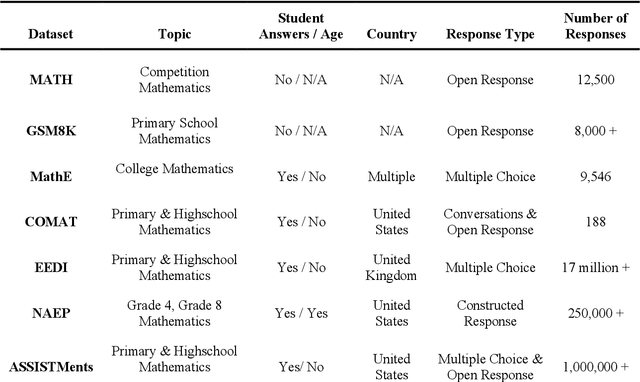
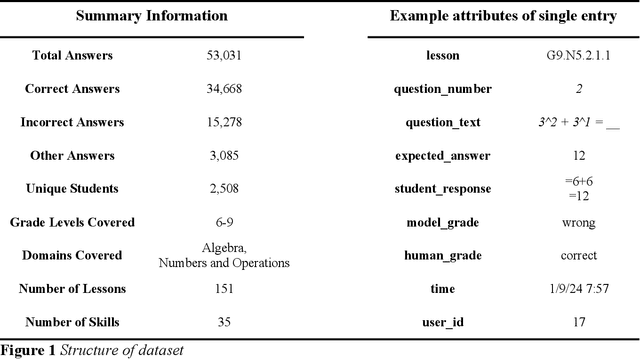

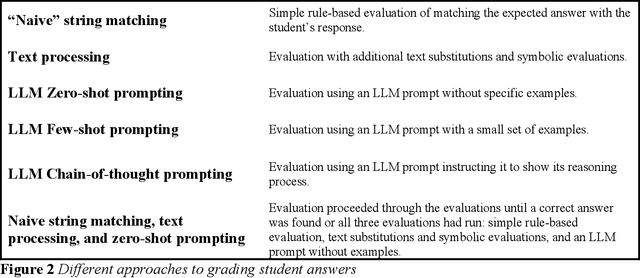
Abstract:This paper introduces AMMORE, a new dataset of 53,000 math open-response question-answer pairs from Rori, a learning platform used by students in several African countries and conducts two experiments to evaluate the use of large language models (LLM) for grading particularly challenging student answers. The AMMORE dataset enables various potential analyses and provides an important resource for researching student math acquisition in understudied, real-world, educational contexts. In experiment 1 we use a variety of LLM-driven approaches, including zero-shot, few-shot, and chain-of-thought prompting, to grade the 1% of student answers that a rule-based classifier fails to grade accurately. We find that the best-performing approach -- chain-of-thought prompting -- accurately scored 92% of these edge cases, effectively boosting the overall accuracy of the grading from 98.7% to 99.9%. In experiment 2, we aim to better understand the consequential validity of the improved grading accuracy, by passing grades generated by the best-performing LLM-based approach to a Bayesian Knowledge Tracing (BKT) model, which estimated student mastery of specific lessons. We find that relatively modest improvements in model accuracy at the individual question level can lead to significant changes in the estimation of student mastery. Where the rules-based classifier currently used to grade student, answers misclassified the mastery status of 6.9% of students across their completed lessons, using the LLM chain-of-thought approach this misclassification rate was reduced to 2.6% of students. Taken together, these findings suggest that LLMs could be a valuable tool for grading open-response questions in K-12 mathematics education, potentially enabling encouraging wider adoption of open-ended questions in formative assessment.
Can Large Language Models Make the Grade? An Empirical Study Evaluating LLMs Ability to Mark Short Answer Questions in K-12 Education
May 05, 2024

Abstract:This paper presents reports on a series of experiments with a novel dataset evaluating how well Large Language Models (LLMs) can mark (i.e. grade) open text responses to short answer questions, Specifically, we explore how well different combinations of GPT version and prompt engineering strategies performed at marking real student answers to short answer across different domain areas (Science and History) and grade-levels (spanning ages 5-16) using a new, never-used-before dataset from Carousel, a quizzing platform. We found that GPT-4, with basic few-shot prompting performed well (Kappa, 0.70) and, importantly, very close to human-level performance (0.75). This research builds on prior findings that GPT-4 could reliably score short answer reading comprehension questions at a performance-level very close to that of expert human raters. The proximity to human-level performance, across a variety of subjects and grade levels suggests that LLMs could be a valuable tool for supporting low-stakes formative assessment tasks in K-12 education and has important implications for real-world education delivery.
Using State-of-the-Art Speech Models to Evaluate Oral Reading Fluency in Ghana
Oct 26, 2023Abstract:This paper reports on a set of three recent experiments utilizing large-scale speech models to evaluate the oral reading fluency (ORF) of students in Ghana. While ORF is a well-established measure of foundational literacy, assessing it typically requires one-on-one sessions between a student and a trained evaluator, a process that is time-consuming and costly. Automating the evaluation of ORF could support better literacy instruction, particularly in education contexts where formative assessment is uncommon due to large class sizes and limited resources. To our knowledge, this research is among the first to examine the use of the most recent versions of large-scale speech models (Whisper V2 wav2vec2.0) for ORF assessment in the Global South. We find that Whisper V2 produces transcriptions of Ghanaian students reading aloud with a Word Error Rate of 13.5. This is close to the model's average WER on adult speech (12.8) and would have been considered state-of-the-art for children's speech transcription only a few years ago. We also find that when these transcriptions are used to produce fully automated ORF scores, they closely align with scores generated by expert human graders, with a correlation coefficient of 0.96. Importantly, these results were achieved on a representative dataset (i.e., students with regional accents, recordings taken in actual classrooms), using a free and publicly available speech model out of the box (i.e., no fine-tuning). This suggests that using large-scale speech models to assess ORF may be feasible to implement and scale in lower-resource, linguistically diverse educational contexts.
Can LLMs Grade Short-answer Reading Comprehension Questions : Foundational Literacy Assessment in LMICs
Oct 26, 2023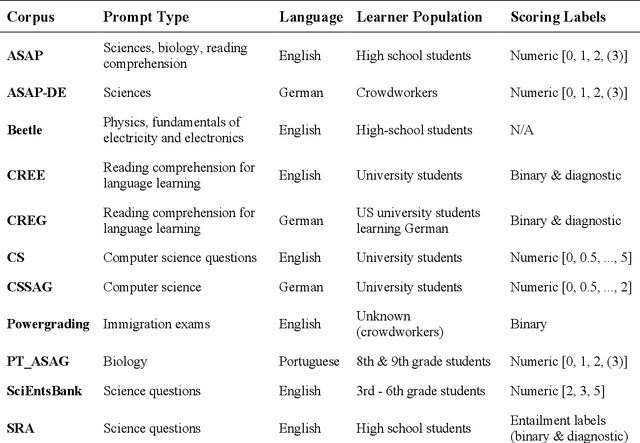
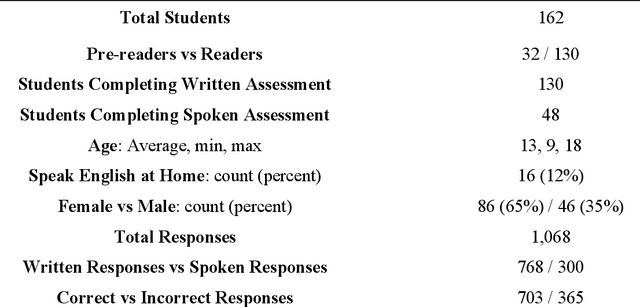


Abstract:This paper presents emerging evidence of using generative large language models (i.e., GPT-4) to reliably evaluate short-answer reading comprehension questions. Specifically, we explore how various configurations of generative (LLMs) are able to evaluate student responses from a new dataset, drawn from a battery of reading assessments conducted with over 150 students in Ghana. As this dataset is novel and hence not used in training runs of GPT, it offers an opportunity to test for domain shift and evaluate the generalizability of generative LLMs, which are predominantly designed and trained on data from high-income North American countries. We found that GPT-4, with minimal prompt engineering performed extremely well on evaluating the novel dataset (Quadratic Weighted Kappa 0.923, F1 0.88), substantially outperforming transfer-learning based approaches, and even exceeding expert human raters (Quadratic Weighted Kappa 0.915, F1 0.87). To the best of our knowledge, our work is the first to empirically evaluate the performance of generative LLMs on short-answer reading comprehension questions, using real student data, and suggests that generative LLMs have the potential to reliably evaluate foundational literacy. Currently the assessment of formative literacy and numeracy is infrequent in many low and middle-income countries (LMICs) due to the cost and operational complexities of conducting them at scale. Automating the grading process for reading assessment could enable wider usage, and in turn improve decision-making regarding curricula, school management, and teaching practice at the classroom level. Importantly, in contrast transfer learning based approaches, generative LLMs generalize well and the technical barriers to their use are low, making them more feasible to implement and scale in lower resource educational contexts.
Retrieval-augmented Generation to Improve Math Question-Answering: Trade-offs Between Groundedness and Human Preference
Oct 04, 2023



Abstract:For middle-school math students, interactive question-answering (QA) with tutors is an effective way to learn. The flexibility and emergent capabilities of generative large language models (LLMs) has led to a surge of interest in automating portions of the tutoring process - including interactive QA to support conceptual discussion of mathematical concepts. However, LLM responses to math questions can be incorrect or mismatched to the educational context - such as being misaligned with a school's curriculum. One potential solution is retrieval-augmented generation (RAG), which involves incorporating a vetted external knowledge source in the LLM prompt to increase response quality. In this paper, we designed prompts that retrieve and use content from a high-quality open-source math textbook to generate responses to real student questions. We evaluate the efficacy of this RAG system for middle-school algebra and geometry QA by administering a multi-condition survey, finding that humans prefer responses generated using RAG, but not when responses are too grounded in the textbook content. We argue that while RAG is able to improve response quality, designers of math QA systems must consider trade-offs between generating responses preferred by students and responses closely matched to specific educational resources.
 Add to Chrome
Add to Chrome Add to Firefox
Add to Firefox Add to Edge
Add to Edge